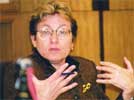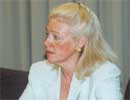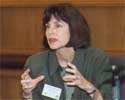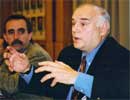Cracking the Code: Creating New Lifelines between Journalists and Academics
Successful Academic-Newsroom Partnerships
Universities and media companies have partnered in successful research ventures. Audits, in which academics measure and analyze content and feed their findings back to the journalists, supplied numerous examples of useful models. Other questions have been tackled successfully, including circulation patterns, newsroom demographics and fairness in political coverage. Here are some highlights of models that have worked.
Content Audit – Middle East Coverage
The Philadelphia Inquirer with Louisiana State University
For about three years The Philadelphia Inquirer had received tough reader reaction about its Middle East coverage from the Israeli and Palestinian communities in Philadelphia. Philadelphia has the fourth-largest Jewish population in the country.
The leader of a large Jewish community group and the Jewish Exponent newspaper began attacking the newspaper for its coverage and their allegations got picked up on talk radio. The Inquirer’s editor and the editorial page editor received death threats. There was even a bomb threat when the editor attended a function at a local synagogue.
Arlene Morgan: “So this was serious. As soon as I became the readership editor, the complaints started coming to me. I thought, ‘I’m not getting into this because I don’t know whether the coverage has been fair or not fair, and there’s no statistical proof one way or the other.’ Yet the newspaper is taking a typically defensive posture that we’re fair and unbiased. And I don’t know that.
 “So I went to Jack Hamilton at Louisiana State and said, ‘Come in and let’s do a content audit. Then we will be public about it. We’ll put it online. We’ll have public meetings. We’ll invite anybody in and we will have real serious discussions about this.’ And we did it. “The complaints stopped. Now, I don’t know if there is a cause and effect here, but I do know we had a new foreign editor and new people on the beat, and I do think they paid attention to this.
“So I went to Jack Hamilton at Louisiana State and said, ‘Come in and let’s do a content audit. Then we will be public about it. We’ll put it online. We’ll have public meetings. We’ll invite anybody in and we will have real serious discussions about this.’ And we did it. “The complaints stopped. Now, I don’t know if there is a cause and effect here, but I do know we had a new foreign editor and new people on the beat, and I do think they paid attention to this.
“We found we pretty much provided equal coverage to both sides. We were coming down the middle on the way we were reporting the stories. We did find that we could have improved on the range and quality of our Palestinian sources.
“We also saw how much we were taking a peace position, and the people in the community who were most critical were not necessarily for peace in Israel if it meant that Israel would be jeopardized.
“We learned a great deal from these conversations.
“We really did look at our coverage much more judiciously. And we actually went out to the public and held meetings. The fact that Louisiana State University had nothing to do with Philadelphia, was a neutral entity and not a Penn or Temple, and that the staff took it seriously, really went to the heart of creating a conversation in the community that was open and honest.”
Crime Reporting
Berkeley Media Studies Group, Missouri School of Journalism, Los Angeles Times, San Jose Mercury News
The Berkeley Media Studies Group – with Lori Dorfman and Jane Stevens – had developed a crime reporting handbook that helped newsrooms develop a public health approach to reporting on crime and violence.
The Missouri School of Journalism then did content analyses of the Los Angeles Times and San Jose Mercury News, examining the impact of traditional crime and violence reporting. Reader surveys looked at how such coverage affects readers’ perceptions of their neighborhoods and their personal safety. Those materials were then used for crime reporting training at The Philadelphia Inquirer.
Esther Thorson: “We could report out how crime and violence reporting has a certain look and feel to it that emphasizes fear and has a number of what we consider to be negative aspects.
“We surveyed readers in Los Angeles and San Jose to find out: Do readers want to be exposed to all of this blood, guts and gore? What is their perception of their neighborhoods and city? How do they deal with personal danger?
“We put together the content analyses with the surveys of the readers and used them in Philadelphia to demonstrate how the current crime and violence focus in news leads to certain outcomes for readers.”
Arlene Morgan: “This wasn’t some feel-good, point-your-finger and this-is-how-you- should-be-doing-things research, but it really had a strong research and case-study component based on other journalism models … The researchers also did an analysis of our own work and brought it back to us.
“One effect was that the staff thought about their coverage differently. Two of the people in the training went to work on a project that was a finalist for the Pulitzers two years in a row in public service, looking at crime and rape in Philadelphia.
“The city editor, Marc Duvoisin, told me over and over again that [the training] really did help fashion how the reporters talked about the way they were going to do that project.”
Content Audits
Los Angeles Times with the Missouri School of Journalism
The university has been involved with the Los Angeles Times, the St. Paul Pioneer Press, the Minneapolis Star Tribune and WCCO-TV in a Ford Foundation-sponsored effort to think through how these news organizations are covering diversity and change.
The researchers use a three-pronged approach. First, they do extensive content analyses of every section of the newspaper and each TV news broadcast to determine how many minorities, women and men and various age groups are represented. They then look at the coverage across a range of socioeconomic variables, including the roles people play, who’s the source, who the story is about and the domain of the topic, such as sports versus crime.
They then interview a random sample of journalists in the newsroom to determine what they think about the whole issue of diversity. Then they survey a large, random sample of people in the city – both readers and non-readers, viewers and non-viewers – to see what people think.
Key to the process is feeding the results back to the newsroom to ensure that no newsroom motives are inferred from what may be editorial policy directives.
Esther Thorson: “We try to come at the issue of diversity not just from a single point of view and not just with what’s in the news medium. We look at what the people who are producing the news reports are thinking about, what’s in it, and what readers and viewers think. 
“We provide extensive feedback to the newsroom. For example, in Los Angeles, when we first did the content analysis, we worked with the international folks, we fed back to the photographers, we talked to their top team of editors and we talked to the political writers.
“It was really great in a couple of ways. First of all, newspapers don’t realize what their content looks like over time. They know what it looked like yesterday, and they think they know what it’s going to look like tomorrow, but they don’t know what it looked like over the last year or two.
“Secondly, we learned that content analysis has a ways to go. For example, we were talking to the photographers and we said, ‘You know, a lot of your photographs are of people doing nothing, like nothing is happening.’
“And they said, ‘Oh, of course,’ because their top editors insist they take these real big – I don’t know what these shots are called – but just the face part. So you never know what anybody’s doing because you’re just seeing them emote and not in any context.
“It gave a certain look and feel to the paper, but we didn’t know they were doing that on purpose.
“Then we were talking to the international folks and we said, ‘You know, it’s kind of funny, with all the people who live in Los Angeles and come from Central America, there’s no Central American coverage.’
“They said, ‘Excuse us, we have three people down there.’ We said, ‘Well, sorry, there are no stories.’ They insisted we were wrong, so we went home and we counted again, and there were no stories out of Central America.
“It turns out that they did have reporters down there, but they had never published any of their stories.
“It was a good give and take. What was especially good was that, as academics, we learned a lot in this ongoing process … You have to feed that content analysis back before you know it’s right. You can’t just go out and publish it, which was the way we’d usually done things.
“After all this feedback comes in, you hope to start to see change … All of the media have really made major efforts to change.
“We’re continuing to track and do the content analysis. The L.A. Times established a Latino initiative. It had 25 reporters who were interested in what the Latino community was doing and they just tried to produce stories.
“So we tracked that and, sure enough, the presence of Latinos started going up and stereotyping into victims and perpetrators or poor people, stuff like that, started to go down.”
Diversity Content Audits
St. Paul Pioneer Press, Star Tribune, WCCO-TV with the Missouri School of Journalism
At the St. Paul Pioneer Press, the researchers did a content analysis of 21 editions of the paper, front to back, not just page one. Ahead of time, they put some effort into identifying key people in the Twin Cities, so they knew their ethnicity and could be sure of the diversity of sources. That helped make the findings credible in the newsroom.
The researchers also developed a technique they call “reverse tracking,” where they color code with magic markers the people appearing in news stories. For instance, Caucasian males are marked with yellow markers. Then they talk through the news process, addressing such points as: Could this story have been written differently? Could it have had more variety in the sources? Why was this story selected instead of another? The goal is to help discern why the coverage is not as diverse as the community from which it emerged.
Nancy Conner: “The outcome was sort of shocking to us because we had spent years hiring women and making a big point out of good women’s coverage. We’d raised the readership numbers back up some, so that we had as many women reading the paper as men.
“Yet, we found that only 20 percent of the people quoted in the stories were women. Unbelievable. It’s the same thing all over the country.”
Esther Thorson: “That’s true. Every single newspaper we’ve audited is 20 percent women, which leads you to believe that there’s something driving that. That’s not an accidental number since it continually appears, so something’s going on with the process.”
Nancy Conner: “The reporters were just shocked.”
Esther Thorson: “Well, first of all, they say, ‘No, it’s not true.’ ”
Nancy Conner: “The other thing they say is, of course, the newsmakers are largely men. There are very few women in the legislature or in Congress. What do you do? They feel frustrated because business leadership is largely male, too. And the editors say the same thing.
“Now they’re caught between reporting what’s really happening out there in the traditional news sense or making this huge effort to go out and find people who aren’t newsmakers and put them in the paper. So it’s become a good tension back and forth.”
Phil Meyer: “Did you consider a mainstreaming program like USA Today’s, where reporters are told to cycle through their lists of females and minorities, so that they force them into the paper?”
Nancy Conner: “Philosophically, that would not work for our reporters or editors.”
Phil Meyer: “It’s the only way to do it.”
Esther Thorson: “No, that’s not true. Putting quotas on people doesn’t work. I think the reverse tracking that we did with the entertainment group – and you can’t say that there are no women or minorities in entertainment, right? When we did reverse tracking, the response was, ‘I bet we could do this differently.’ And that’s what they’re attempting to do.”
Nancy Conner: “As reader advocate, I have to trace through a lot of ‘How did this happen in the paper?’ kinds of things. 
“You find out there are seven or eight different decision points in which someone either stays in a story or not, someone’s either in a photo or not, the photo does or doesn’t run.
“That is what reverse tracking is helping us figure out now: At what decision points do certain minorities and women get left out? Maybe they’re really haphazard decisions that didn’t have to be made that way at all.”
Dave Kurpius: “I think the key issue with content audits is pinpointing what you are trying to answer. I don’t think the key question, frankly, is whether we have enough people of color in the newspaper. I think the question is whether the content we do have in the newspaper is relevant to the lives of people of color.
“Remember, our business is not to just make sure that we’ve equaled out everything in terms of the number of bylines or references based on gender or race. Our business is to print or broadcast content that is relevant to those lives.”
Esther Thorson: “This is a two-way-street concept of research. It’s not the academics going in there and saying, ‘I’m going to see if you guys are fair and diverse’ … No. It’s let’s work in partnerships where what we bring to the table are research skills.
“We can measure stuff and then you can look at it and do whatever you want with it. And then if you think your paper doesn’t look like what you want it to look like, we’ll do ongoing measurement for you so that you can fight all the complexity of what you have to do to create change.”
Nancy Conner: “Journalists have short attention spans and the longer it takes to get research results and the longer it takes to figure out what we’re going to do next, the more the newspaper is ready to go off on something else … So speed is one thing that really helps.”
Fairness Audits
Minnesota News Council with the University of Minnesota School of Journalism
The Minnesota News Council a few years ago asked the journalism school to research a complaint brought by a third-party candidate for governor who had spent enormous amounts of money in the campaign. He did a walking tour around the state and assumed he should have had massive coverage. But, compared to other candidates, he got almost none.
Ev Dennis: “The questions newspapers were eager to know: What was the relative balance of content? Who got coverage for what? Were they positive or negative portrayals? What was the emphasis in the news? 
“It led to a very good debate about the nature of fairness, because fairness is more than just numbers added up in columns. We debated the whole question of how news decisions came about, in this case, how third-party candidates fared.”
Newsroom Demographics and Attitudes
American Society of Newspaper Editors with Indiana University
In 1996, the university constructed a questionnaire and scientific sample of the newsroom workforce for daily newspapers in the United States and compared it with a 1988 study.
Gene Foreman: “That was a success story … It had a lot of tremendously useful information for workforce managers on demographics and attitudinal changes over time … and what individual staff members thought they needed.
“One of the things they said [was that] we needed stronger middle-level editors. A lot of us did react to that and provided training opportunities for good journalists who were promoted to a position where they supervised other journalists.”
Circulation Studies
Knight Ridder and The Philadelphia Inquirer
Phil Meyer examined circulation patterns in the Philadelphia region, which were being explained on the basis of race or economic characteristics. Meyer came up with a model that adjusted for demographic characteristics to enable the news organization to see where it was doing well or poorly compared with what the demographics would suggest.
Phil Meyer: “This was the first time the circulation people knew we were doing this. Their reaction was immediate and defensive because if there was an area that was below par compared to the demographics, they thought we were accusing them of not doing a good job.
“This story has a happy ending because [the editor, Gene] Roberts saw that the places where The Inquirer [circulation] was lower than the demographics would predict were in the suburban areas. And that led him to the suburban strategy where he opened more bureaus. And the Philadelphia Bulletin couldn’t get its trucks out to those remote areas.
“So, as I tell the story, I’m the guy who killed the Philadelphia Bulletin with the power of research. But I suspect that’s an exaggeration.”
